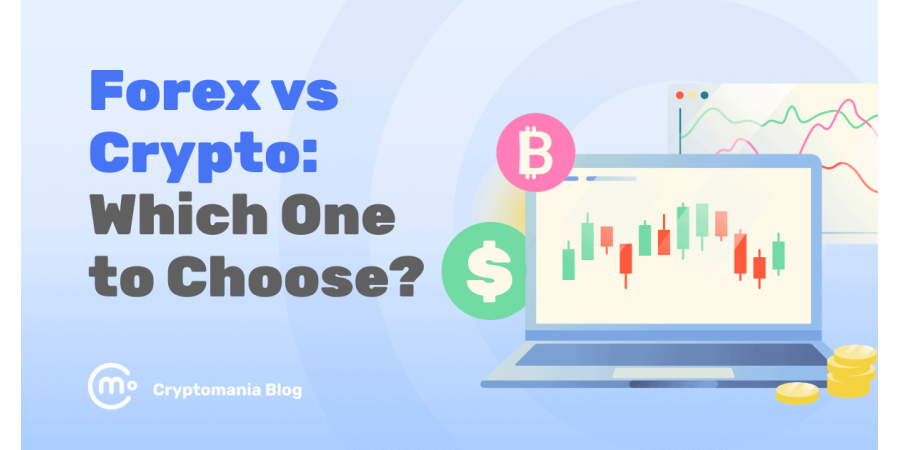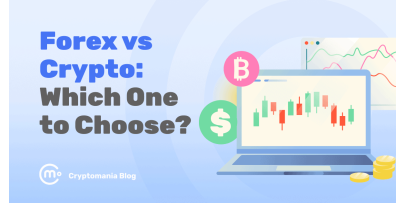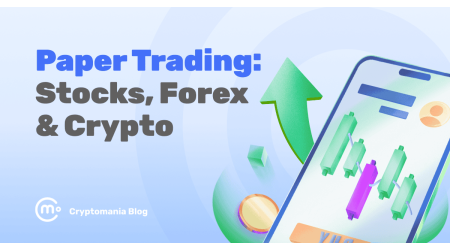

Stuck choosing between Forex vs crypto trading?
I get it. It’s like needing to pick a team in a game you don’t understand.
Both offer a chance to grow your money, both show up all over YouTube and TikTok, and both come with charts, lingo, and wild success stories.
Forex and crypto may look similar on the surface (buy low, sell high), but under the hood, they run on different engines.
One is built on traditional finance, the other on digital rebellion.
So which one should you start with?
This guide will break down what each market is, how they work, where they shine (and where they fall flat). And, most importantly: which one fits your style as a new trader.
Let’s start with the world’s biggest market that most people never think about.
Forex trading basics
What is Forex?
Forex stands for foreign exchange. It’s the global market where you trade one currency for another. It’s like swapping U.S. dollars for euros, or yen for British pounds.
But you’re not trading at the airport kiosk. You’re doing it digitally, through brokers and platforms built for speed.
And it’s huge.
We’re talking $7.5 trillion in daily volume. That’s more than the stock and crypto markets combined. Every time a tourist books a hotel abroad or a company pays an overseas supplier, forex is in play.
How does Forex work?
- You trade currency pairs (like EUR/USD or GBP/JPY)
- The goal is simple: buy low, sell high (or vice versa)
- The market runs 24 hours a day, 5 days a week
- Most trades are short-term (minutes to hours)
Let’s say you think the euro will rise against the dollar. You buy EUR/USD. If the euro strengthens, you profit. If it drops, you lose.
Easy to explain. Hard to master.
What makes Forex unique?
- High liquidity: Major currencies like the U.S. dollar or euro are traded constantly, so getting in and out of trades is fast and easy.
- Lower volatility: Compared to crypto, Forex is more stable. Price swings happen, but not 30% in a day.
- Lots of leverage: Most Forex brokers offer leverage, sometimes up to 100:1. That means you can control a large position with a small deposit. Great for profits. Dangerous for beginners.
- Regulation: Because forex has been around forever, it’s tightly regulated. That gives you more protection, if you pick a good broker.
Forex terms you’ll hear
- Pips – the smallest price move a currency pair can make
- Lots – the unit of trade size
- Spreads – the difference between buying and selling price
- Leverage – borrowed money to increase your position size
Don’t worry if that sounds like gibberish. It’ll make sense over time. For now, just remember: forex is about real-world currencies moving on global events, central bank decisions, and economic reports.
It’s the “grown-up” trading market. But that doesn’t mean it’s boring. It’s just different.
Crypto trading basics
What is crypto trading?
Crypto trading is the buying and selling of digital coins like Bitcoin, Ethereum, and thousands of others you’ve probably heard about from a friend, a headline, or a random tweet.
Unlike forex, which deals with government-backed currencies, crypto trades digital assets that live on the blockchain.
You’re not trading dollars for euros. You’re trading Bitcoin for USDT. Or Ethereum for Solana. All online. All the time.
And yes, it runs 24/7. No closing bell. No weekends off.
How does crypto trading work?
- You trade crypto pairs (like BTC/USDT or ETH/BTC)
- The goal: buy low, sell high
- You trade on crypto exchanges (like Binance, Coinbase, Bybit)
- Most traders focus on short-term moves, but some hold for years
Let’s say you believe Bitcoin is about to rise. You buy BTC/USDT. If BTC goes up, you profit. If it drops, you lose. Just like Forex, but usually faster.
What makes crypto different?
- High volatility: Prices can jump or crash 10% or more in a single day. Sometimes in minutes. That’s why crypto day trading is so popular.
- Around-the-clock access: Crypto never sleeps. You can trade at 2 a.m. on a Sunday.
- More risk, more reward: Big gains are possible. But so are big losses. Many altcoins rise fast. And they can fall even faster.
- No central bank: Crypto prices don’t react to interest rates or inflation numbers in the same way fiat does. They move on hype, trends, and sometimes pure speculation.
- Tens of thousands of options: While Forex focuses on a few dozen currency pairs, crypto has over 20,000 coins. Most aren’t worth your time. A few have serious potential.
Crypto terms you’ll hear
- Altcoins – any crypto that isn’t Bitcoin
- Stablecoins – digital assets like USDT or USDC, designed to stay at $1
- Crypto bull market – a period when almost all cryptocurrencies rise in value. The opposite is a crypto bear market
- Wallets – where you store your crypto (can be online or offline)
- Slippage – when the price moves during your order, and you get a worse deal
- Gas Fees – small transaction costs (especially on Ethereum)
Crypto trading is fast, exciting, and often chaotic. It’s the “wild west” of finance. The gains can be huge. So can the crashes.
If you’re comfortable with digital platforms, like trying new tech, and can handle risk, crypto might speak your language.
Forex vs crypto trading: Key differences
At first, Forex and crypto look similar. You’re trading one asset for another, watching charts, and hoping to profit from price moves.
But once you zoom in, the differences become obvious. These two markets run on different rules, speeds, and mentalities.
Here’s how they compare.
1. Market hours
- Forex runs 24 hours a day, Monday through Friday
- Crypto runs 24/7, including weekends and holidays
If you want to trade at 3 a.m. on a Sunday, only crypto is open. Forex takes the weekend off.
2. Volatility
- Crypto is far more volatile: Bitcoin can drop 10% in a day. Some altcoins move 20-30% within hours.
- Forex is more stable: Major pairs like EUR/USD rarely move more than 1 percent in a day.
That means more opportunities for big gains in crypto, but also more risk.
3. Regulation
- Forex is heavily regulated, especially in major countries
- Crypto has some regulation, and it’s getting more and more regulated by the month. But it’s still catching up compared to Forex.
Forex brokers need licenses. Crypto exchanges vary. Some are well-regulated, others not at all. Generally speaking, your money is more protected in Forex, assuming you choose a trustworthy broker.
4. Leverage
- Forex brokers often offer 50:1 or even 100:1 leverage
- Crypto platforms offer similar leverage, but the market swings harder
Both let you trade with borrowed money, which can boost your gains. Or wipe you out fast.
5. Liquidity
- Forex has deep liquidity, especially in major pairs
- Crypto has high liquidity for top coins (like Bitcoin and Ethereum), but lower for small-cap tokens
It’s easier to get in and out of trades quickly in forex. In crypto, some coins can spike or crash because of just a few large trades.
6. Number of assets
- Forex has fewer trading pairs: Most traders stick to major and minor currency pairs
- Crypto offers thousands of coins and tokens (around 25,000 at the time of writing)
This can be a blessing or a trap. The variety is fun, but most tokens are hype with no real value.
7. What moves the market
- Forex reacts to real-world news: interest rate decisions, inflation reports, global politics
- Crypto historically reacts to hype, sentiment, tech updates, regulations, and even tweets. Though more recently, it’s also been reacting to the same things as Forex.
At a glance: Forex vs crypto quick comparison table
| Feature | Forex | Crypto |
| Market hours | 24/5 | 24/7 |
| Volatility | Low to moderate | High |
| Regulation | Strong | Medium (varies) |
| Leverage | Up to 100:1 | Up to 125:1 (some exchanges) |
| Liquidity | Very high in major pairs | High in top coins, low in altcoins |
| Assets available | Dozens of currency pairs | Thousands of coins and tokens |
| Market drivers | Economic data, central banks | Sentiment, tech, media, hype (but more recently also economic data and central banks) |
This side-by-side view helps show the real contrast. Forex is grounded, rule-based, and slow-moving. Crypto is fast, emotional, and often unpredictable.
Pros and cons of Forex trading for beginners
Forex is the biggest trading market in the world. It’s steady, regulated, and packed with liquidity. But it’s not all upside, especially if you’re just starting out.
Let’s break down the good and the bad.
Pros of Forex trading
- High liquidity: Major currency pairs like EUR/USD or USD/JPY are traded constantly. That means tighter spreads, quick order execution, and less chance of slippage.
- Lower volatility: Prices move in smaller, more predictable ranges. A 1 percent move is a big deal in Forex. This can make it easier to manage your risk compared to crypto.
- Strong regulation: If you stick with a licensed broker, you get more transparency and more protection. Regulation helps keep scams and shady activity in check.
- Economic logic: Forex markets move based on real-world data. Things like inflation reports, interest rates, and central bank decisions. If you like understanding how global events move markets, Forex gives you that structure.
- Plenty of education: Because Forex has been around so long, there are tons of free courses, YouTube channels, and demo platforms to learn from.
Cons of Forex trading
- Smaller profit potential per trade: Lower volatility means it can take longer to grow your account. You won’t see 30 percent jumps in a day.
- Complex for some beginners: Understanding interest rates, macroeconomics, and central bank policies can feel overwhelming at first.
- Overuse of leverage: While leverage can help boost returns, it’s also dangerous. Many beginners blow up accounts because they overtrade or use too much borrowed money.
- Fewer opportunities to “go viral”: There’s no meme hype or overnight moonshots here. Forex trading is more of a grind. It rewards consistency, not lucky bets.
Pros and cons of crypto trading for beginners
Crypto feels like the Wild West of trading. It’s fast, loud, and full of opportunity. But it’s also risky, unpredictable, and sometimes downright chaotic.
Let’s look at what makes it appealing. And what makes it dangerous.
Pros of crypto trading
- Big price swings mean big opportunities: Crypto markets move fast. A coin can gain 10, 20, or even 100 percent in a week. That kind of volatility creates chances for huge profits, even on small trades.
- Always open: Unlike Forex or stocks, crypto markets run 24/7. You can trade any day, any hour. Great for people with busy schedules or those in different time zones.
- Low barrier to entry: You can start trading crypto with just $10 on many exchanges. There’s no need for a big deposit or a long account setup process.
- Fast-growing ecosystem: Crypto isn’t just Bitcoin anymore. There are tokens for gaming, finance, artificial intelligence, and more. If you’re interested in tech and innovation, crypto has something for you.
- Early mover potential: Because many crypto projects are still new, early buyers can sometimes get in before the crowd. That kind of upside doesn’t happen often in traditional markets.
Cons of crypto trading
- Extreme volatility: While big swings create profit potential, they also mean bigger losses. Many coins drop 30 percent or more in a day. It’s not unusual for a trending token to crash just as fast as it pumped.
- Less regulation: Many crypto exchanges operate in legal gray zones. That means fewer protections for your funds if something goes wrong. Hacks, rug pulls, and platform shutdowns are all real risks.
- Too many choices, not enough quality: There are thousands of coins, but only a handful are solid long-term projects. New traders often get pulled into hype coins with no real value.
- High emotional pressure: FOMO (fear of missing out) and hype move the market more than logic. It’s easy to get caught up in trends, chase pumps, and panic sell during crashes.
- Scams and shady projects: From fake coins to phishing links to “too good to be true” staking offers, scams are everywhere. You have to be extra cautious and always do your research.
Which one should you start with?
Both Forex and crypto have steep learning curves. But the way you learn and what you need to learn depends on the market.
Forex has been around for decades. It offers more structured education, regulated brokers, and access to demo accounts where you can practice without losing real money.
If you like clear rules, economic data, and step-by-step strategies, Forex will feel more familiar. It’s slower-paced, and many traders treat it like a long-term craft.
Crypto is faster, flashier, and often more intuitive, especially if you’re already comfortable with tech. You don’t need to understand central banks or inflation rates. But you do need to understand risk.
The crypto world is full of hype, fast moves, and new platforms popping up every week. It rewards curiosity and speed, but punishes emotional decisions harder.
So which one fits you better?
Ask yourself:
- Do you prefer stable, structured environments? If yes, Forex might be a better fit.
Prefer fast, open systems and flexibility? Then crypto could suit you more. - Want to trade part-time, a few hours a week? Forex works well for scheduled trading.
Want to jump in anytime, even on weekends? Crypto runs 24/7. - Are you more comfortable with lower risk and predictable moves? Forex is more stable.
Okay with high risk for the chance at higher rewards? That’s crypto territory. - Would you rather learn with proven tools and traditional strategies? Go with Forex.
Curious about new tech and like exploring new platforms? Crypto may be your space.
There’s no perfect answer. The best market for you is the one that matches your personality, your goals, and how you like to learn.





